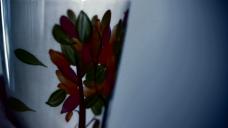
-
That is exactly the point: it happens slower. It does slow one down and prevents one from having a bunch of jerky nervous reactions and instincts. When there are not a thousand buttons to push one has nothing in the way of actually thinking before doing.
With digital they all just put it in a green mode and shoot away without understanding why things happen certain way.
With a zoom lens they just become lazy in the way they frame their shots. When one has nothing but a 50mm lens one has to "zoom" with their feet in a process discovering angles they wouldn't otherwise.
With auto-focus they ignore a creative device of shifting one attention to something subtly, and then again the green mode would put camera into f/11 so everything is sharp. Good for ENG, not so good for film-making and telling stories.
I do love digital it does make things easy and fast, it's just when I watch student film festivals I can tell which ones of them had a traditional b&w or film background and make beautifully looking images with a $300 cam-coder provided by AV desk at college and which ones of them are "Jimmy wants to be a film-maker" (ie. sucks in math and everything else) and produce "local news at five" looking stuff with a $30K RED kit.
There are of course exceptions. -
I still think that it is screwed POV.
Giving them such cameras and slowing any progress you really do not get anything in return.
What prevents you to have classes about shooting with primes in manual modes?
I don't get it.
I think that for you it is some form of abstract idea. Common for many guys who know how to shoot.
It do not work in reality. -
No, it actually is not an abstract idea. And yes, it does work in reality. For starters it worked for me. After years of being an early adopter of digital photography I started to notice an increasing prevalence of mylnitsa-style (mylnitsa being a Russian term for a cheap consumer Kodak or alike camera) images I would produce. I guess it came from the fact that the recording media being abundant I did't have to think quite as hard about how and what I am shooting. So I made a decision to go back to the roots, partially to remove myself from the immediacy that digital allows and partially to explore a different temperament of approach to the image creation. And I think it helped.
The other reason that I believe it is still a good advice for the community college students is that shooting with cheap manual 35mm camera is almost the only affordable way to experience a large "sensor" style of images and all the perks that they have for many of the students. That is of course to be discussed - what looks good to whom. I for once enjoy "filmic" images and don't enjoy "video-y" style of images.
-
>I for once enjoy "filmic" images and don't enjoy "video-y" style of images.
In fact I don't give a fuck about "filmic" images.
As for using film camera - you suffered and want others to go same weird way. It is common for people.
"Why this motherfucker got 5DMkII and is learning such fast? Fuck him, give him $10 secondhand Canon with cheapest 50mm and let him fly."
I think that it could only work if you control source of food :-) -
I found 35mm a bit frustrating in my younger days, as by the time I got my slides back I couldn't remember what had gone wrong (or right). Later I did some B&W developing and printing, but never anything really satisfying just because of the time it all took.
Where I agree with dkitsov is that limitations can be great. Using Hi8 or SVHS was an education, and I haven't forgotten that certain things can be made to look really good on those formats (for example, subtle reflections on glossy surfaces, and careful use of lighting to control the image) and that's something I've kept with me. I had a colleague who taught video and he got me to just do some simple experiments and then stories. For example, I had to go and shoot "circles" as a subject, and that can create some amazing stuff (I remember a simple landscape which revealed a circle when I moved the camera, as the glass I was shooting through had a circular distortion which was only evident when you moved). Or "making a cup of tea" (the latter I set to music, and put a mirror in the sink so I could get a "kettle's eye view" as the water poured down into it). Playing around with these silly ideas, using what were then quite expensive cameras (but still Hi8) was a real education.
It would have been amazing to have a GH2 all those years ago, but I wonder what I would have missed out on discovering for myself? Or maybe I'd have discovered different things. But a brilliant camera won't make you brilliant any more than a brilliant instrument will make you a virtuoso - in the end, surely it all comes down to having good ideas and working really hard at them. -
For learning, you cannot beat the instant feedback of digital. People learn by making connections between cause and effect (or as Vitaliy noted, trial and error). What I've found is that once people have started to gain some mastery, then they have a sufficient skillset to appreciate things like film and taking your time to make deliberate images.
For dkitsov, you had a sufficient level of mastery so that going to real film and taking your time made sense. But for a novice, digital and its instant feedback is much more useful in the early stages. Afterwards, IMHO, it's up to the student to decide whether to move forward by shooting film, continuing with digital, or some other choice.
For the festivals you cite, the issue is one of simple laziness. Film is too expensive to allow someone to be lazy. Digital is cheap enough to let people be sloppy and lazy. It shows in the work. It doesn't imply that film is better; it implies that some people are just lazy.
I'm with Vitaliy on the "filmic look." It's not about the medium; it's about the quality of the effort that creates the look. -
Reality is: If Digital was around for Charlie Chaplin... what would he have done?
Besides: this topic is about 'banding'... any more insight into this issue...? @Vitaliy_Kiselev ? Do you have any more info? Considering your advanced 'journey to the centre of the Earth' with MJPEG & AVCHD? -
Reality is - "Reality is: hypothetical and unrealistic situation" - is a definition of what reality isn't.
Besides, there is no banding with film. Also the reality is that one can own a camera that produces full "sensor" images with a nice bokeh for about 150 USD if it's film; a digital equivalent would be at least 2500 USD. That is the reality. -
-
@dkitsov
Sorry- I didn't want it to become an internet meme! :D
Can you let me know what motion picture camera is 150usd? (8mm?) I WANT 5! -
Well, for what it's worth, I'm a college student, and I found my time with my Zeiss Ikon and the darkroom invaluable. There's something about actually using film and developing it that forces the basics of photography to become embedded in the brain. I shot and developed over 30 rolls of film in a single semester, and by the very nature of it, I spent a TON of time with just me, the 50mm, the aperture, the focus, and the shutter. Learning to think in black and white also worked wonders on my ability to compose an image.
If the class had been digital, I must admit, I'd have taken a lot more photos. But I wouldn't have learned as much. I'd have shot a huge volume of bad pictures, and just pulled the ones that were luckily good.
@VK: what's the deal with banding? are there hack things that will remedy this? -
I think that this topic isn't for discussing the benefit of analogue capture.
Basically I don't understand why such a topic is being discussed on a forum that ONLY exists to further the development of the firmware of various Panasonic Cameras...
I am sure there are many forums on the net 100% focused on film cameras, and their benefit to composition etc... If there is anyone that needs digital to be more 'contemplative' ie: not capturing 1000's of photos for the fun of it: simply save video in raw... 750GB hdd=17mins... That should make people think before they snap away!
Or- what about giving a student a Digital SLR with a 50MB flash card? (shooting in raw only)?
Then give them a 1998 computer... which should take a few minutes to process that data??!
Anyway... Great conversations here... We should make a new forum topic... Film v's Digital
PS: I am sure that David will totally be getting himself a hacked GH2 for his next film ; ) -
I find it strange that the projection is showing his hand- and the way that this is shot only crops his hand as well! However- he is very expressive with his hand...
Regarding what he is talking about- the GH2 kind of brings a film camera into the palm of your hands... great power!
And remember that 4/3 is basically film size,... (its not as big as 5DMkII- but I believe that focus becomes an interesting issue at that size anyway) -
I am trying to find a post about banding where someone said they sent their GH2 back to panasonic and it came back without the banding issue. Does anyone remember this post, or who it was? I ask because I just sent mine in for some spots in the lens, and had a doh moment when I realized I should have mentioned the banding. Just want to know if it really is possible to have fixed, cause I may just send it right back when it comes back if that is the case.
-
Wrong sort of banding - you want this thread: http://www.personal-view.com/talks/discussion/693/gh2-showing-fixed-darker-bandstripe-20-pixels-high-across-footage/p1
-
I agree: having one good prime and an analog machine is the best way to learn photography. Many people underestimate photography.
Though I have just bought one myself, I hate it when I see people with their ugly digital SLR's. Most of them don't know how light works, how the sensor of their camera works, and so on. They have zero understanding of the technical aspects of photography. The reason they get 'decent' results is because digital makes it so much easier: everyone can be photographer today, all it takes is a push of a button. Let the electronics do the work for you. These people just press the button many times enough so that 5 pictures out of 100 will come out 'decent'. "I'm a photographer, fuck yeah".
Not so long ago I met some dude at a party. He had a fancy DSLR. He told me did artschool, photography. When I asked him "so do you shoot in RAW?" - He looks at me as if he misunderstood me. "or maybe RGB?" - and that guys is like, what? Turned out that guy got payed for that gig. -_-
An analog machine, forces you to be careful with what you do. You have to think out everything before you press the button. With analog you don't take as many pictures as you would with digital.
Having one 40 or 50mm prime lens forces you to move. It also learns you about the perspective of a lens. You get used to the feeling of different focal lengths. Before I became interested in photography, I just thought zooming was making the image bigger. Now I can tell you the focal length used in almost any shot in a movie by sight.
Only when you can make a decent picture with an analog cam you can call yourself a decent photographer. Otherwise, piss off with your LCD exposure cheating. Real photographers know their apertures and when to use which by hart.
PS: no offense to digital camera's; just the people who use their artificial intelligence to call themselves a photographer
-
I'm trying to deal with a gradient banding issue this week. If there is a lighter colored wall with shadows in my background, gradient banding becomes a problem. After lots of reading and note-taking, the few things that stand out when trying to reduce/eliminate gradient banding:
1) ETTR (seems a bit controversial to some) and darken your image in post (I use a gamma slider in CS6)
2) Introduce intentional ISO noise in camera (because it must be before quantization) and use NR in post
voila! no gradient banding. So... I've been testing this. The only thing that seems to work is to adjust the gamma until until the scene is so bright that the shadows go away. Not very useful. The in-camera dithering via higher ISO may cover the banding if you leave it in, but Denoiser II doesn't remove the noise and magically take the banding with it. I've read plenty of people blame the 8-bit situation, but I thought maybe these workarounds were going to help me. Is Neat Video the missing link here?
Attached are 3 frame grabs from PrPro CS6. As I play with different gamma settings, the banding becomes very faint, but it doesn't go away until the scene is much too bright - even brighter than what I've shown here. These frames are from Sanity X and a Voigtlander 25mm f/0.95 that I rented for a wedding this weekend.
I've also included entries from my journal taken almost exclusively from PV discussions so that future readers can save themselves some time:
-For minimal banding, you'll want to use an AQ4 patch at a high bitrate with -2 Noise Reduction (Lpowell)
-high exposure and low contrast gives you the best chance to avoid banding in dark areas.
-Banding effects are inevitably worse in dimly lit, gradually contoured areas such as an evening sky.
-And I guess that exposing to the right helps, right? Maximize your gain without clipping essential parts with Smooth -2 contrast. I also use a cooler white balance to use more of the green channel. Works out fine in CC. ( oscillian)
-a bit of noise captured in the image, and then NR in editing, will dither the 8-bit posterisation and then removing the noise gives you a nice clean image.( a more recent answer from 2013)

 Sequence 01.Still003.jpg1920 x 1080 - 290K
Sequence 01.Still003.jpg1920 x 1080 - 290K
 Sequence 01.Still004.jpg1920 x 1080 - 286K
Sequence 01.Still004.jpg1920 x 1080 - 286K
 Sequence 01.Still005.jpg1920 x 1080 - 244K
Sequence 01.Still005.jpg1920 x 1080 - 244K -
I have never seen banding that bad from the GH2. I think you may be experiencing a precision problem with your decoder or workflow.
-
GH2 = 8 bit 4:2:0 sampling. Banding is an issue with nearly all 8 bit formats and is worse with 4:2:0 sampling. This is why 10 bit was such a big deal when Digital Betacam was introduced in the 1990's. It was 10 bit 4:2:2.
-
4:2:0 has got nothing to do with banding.
Howdy, Stranger!
It looks like you're new here. If you want to get involved, click one of these buttons!
Categories
- Topics List23,992
- Blog5,725
- General and News1,354
- Hacks and Patches1,153
- ↳ Top Settings33
- ↳ Beginners256
- ↳ Archives402
- ↳ Hacks News and Development56
- Cameras2,367
- ↳ Panasonic995
- ↳ Canon118
- ↳ Sony156
- ↳ Nikon96
- ↳ Pentax and Samsung70
- ↳ Olympus and Fujifilm101
- ↳ Compacts and Camcorders300
- ↳ Smartphones for video97
- ↳ Pro Video Cameras191
- ↳ BlackMagic and other raw cameras116
- Skill1,960
- ↳ Business and distribution66
- ↳ Preparation, scripts and legal38
- ↳ Art149
- ↳ Import, Convert, Exporting291
- ↳ Editors191
- ↳ Effects and stunts115
- ↳ Color grading197
- ↳ Sound and Music280
- ↳ Lighting96
- ↳ Software and storage tips266
- Gear5,420
- ↳ Filters, Adapters, Matte boxes344
- ↳ Lenses1,582
- ↳ Follow focus and gears93
- ↳ Sound499
- ↳ Lighting gear314
- ↳ Camera movement230
- ↳ Gimbals and copters302
- ↳ Rigs and related stuff273
- ↳ Power solutions83
- ↳ Monitors and viewfinders340
- ↳ Tripods and fluid heads139
- ↳ Storage286
- ↳ Computers and studio gear560
- ↳ VR and 3D248
- Showcase1,859
- Marketplace2,834
- Offtopic1,320














